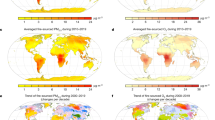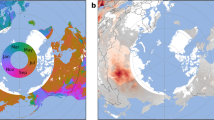Abstract
Model calculations, constrained by satellite observations, indicate that most of the smoke from the oil fires in Kuwait will remain in the lowest few kilometres of the troposphere. Beneath the plume there is a severe reduction in daylight, and a day-time temperature drop of ~10 °C within ~200 km of the source. Episodic events of acid rain and photochemical smog will occur within ~1,000-2,000km of Kuwait. But changes in the Asian summer monsoon are unlikely to exceed the natural interannual variability and stratospheric ozone concentrations are unlikely to be affected.
This is a preview of subscription content, access via your institution
Access options
Subscribe to this journal
Receive 51 print issues and online access
$199.00 per year
only $3.90 per issue
Buy this article
- Purchase on Springer Link
- Instant access to full article PDF
Prices may be subject to local taxes which are calculated during checkout
Similar content being viewed by others
References
Note placed by Secretary of State for Defence in House of Commons Lib., 17 January 1991.
Small, R. D. Nature 350, 11–12 (1991).
Briggs, G. A. Plume rise (US Atomic Energy Commission Rep. No. TID-25075 (US Department of Commerce, Springfield, Virginia, 1969)).
Radke, L. F., Lyons, J. H. Hobbs, P. V. & Weiss, R. E. J. geophys. Res. 95, 14071–14076 (1990).
Golding, B. W. Met. Mag. 119, 81–96 (1990).
Golding, B. W., Goldsmith, P., Machin, N. A. & Slingo, A. Nature 319, 301–303 (1986).
Turco, R. P., Toon, O. B., Ackerman, T. P., Pollack, J. B. & Sagan, C. Science 247, 166–176 (1990).
Warren, S. G. & Wiscombe, W. J. Nature 313, 467–469 (1985).
Nature 349, 96 (1991).
Science 251, 372 (1991).
Pearce, F. New Scientist 129, 30–31 (1991).
Maryon, R. H. & Smith, F. B. Österreich. Beiträge Met. Geoph. 1, 137–146 (1989).
Nicholson, K. W. Atmos. Envir. 22, 2653–2666 (1988).
Jylhä, K. Atmos. Envir. A25, 263–270 (1991).
Ahmed, A. F. M., Singh, R. P. & Elmubarak, A. H. Atmos. Envir. A24, 2927–2934 (1990).
UK Terrestrial Effects Review Group Rep. No. 1, Effects of acid deposition on terrestrial environments in the UK (Department of the Environment, HMSO, 1987).
Folland, C. K., Owen, J., Ward, N. & Colman, A. J. Forecasting 10, 21–56 (1991).
Mitchell, J. F. B. & Slingo, A. J. geophys. Res. 93, 7037–7045 (1988).
Roskilly, R. ECMWF Met. Bull. No. MI 1/6 (1987).
Cess, R. D. Clim. Change 7, 237–251 (1985).
Ghan, S. J., MacCracken, M. C. & Walton, J. J. J. geophys. Res. 93, 8315–8337 (1988).
Cachier, H., Burt-Menard, P., Fontugne, M. & Raucher, J. J. atmos. Chem. 3, 469–489 (1985).
Acid deposition in the UK, 1986–1988, Third Report UK Review Group on Acid Rain (Department of Transport, South Ruislip, UK, 1990).
Author information
Authors and Affiliations
Rights and permissions
About this article
Cite this article
Browning, K., Allam, R., Ballard, S. et al. Environmental effects from burning oil wells in Kuwait. Nature 351, 363–367 (1991). https://doi.org/10.1038/351363a0
Received:
Accepted:
Issue Date:
DOI: https://doi.org/10.1038/351363a0
This article is cited by
-
Analysis of causes and seasonal prediction of the severe floods in Yangtze / Huaihe basins during summer 1991
Advances in Atmospheric Sciences (1995)
-
Oil and combustion-product contamination of the Gulf marine environment following the war
Nature (1992)
-
Kuwaiti soot over Japan
Nature (1992)
-
Effect of Kuwait oil field fires on human comfort and environment in Jubail, Saudi Arabia
International Journal of Biometeorology (1992)
-
Airborne observations of the physical and chemical characteristics of the Kuwait oil smoke plume
Nature (1991)
Comments
By submitting a comment you agree to abide by our Terms and Community Guidelines. If you find something abusive or that does not comply with our terms or guidelines please flag it as inappropriate.



